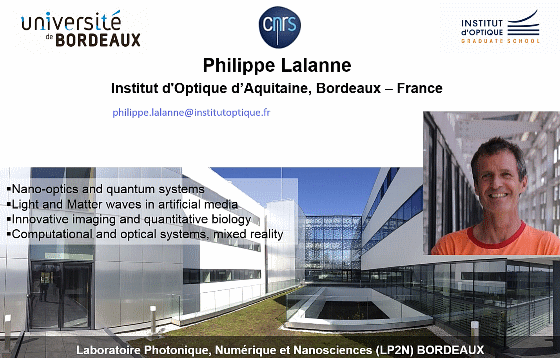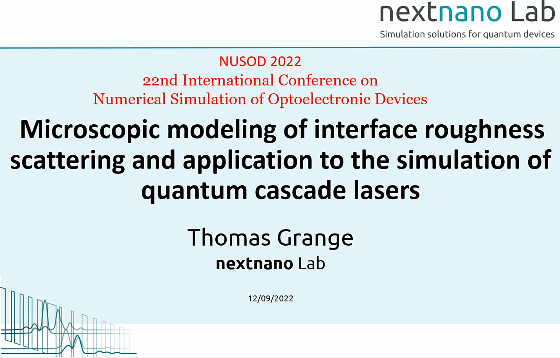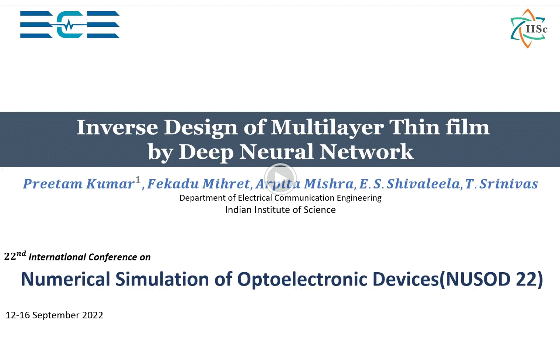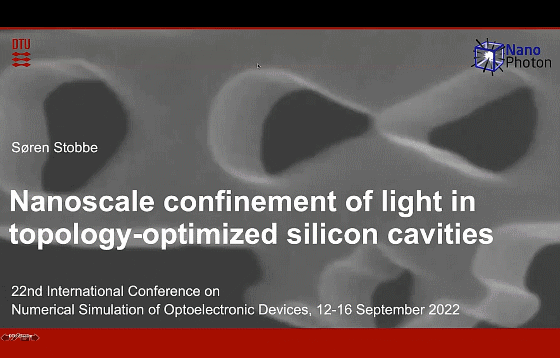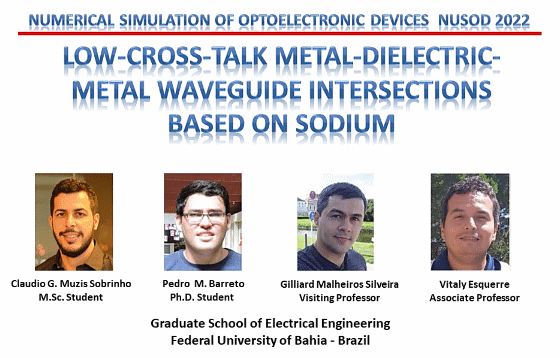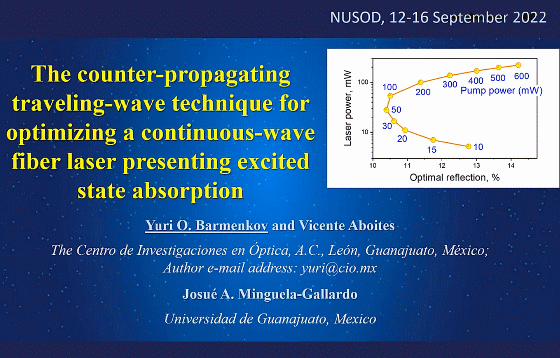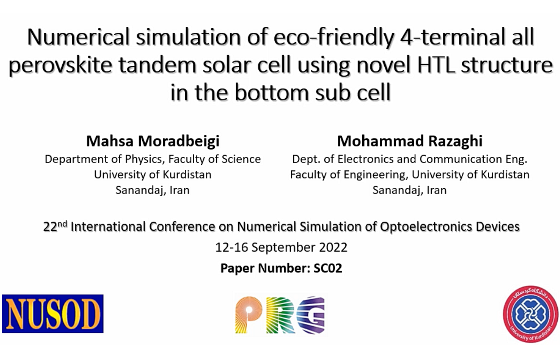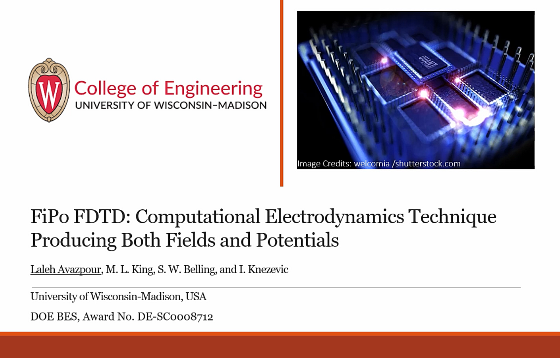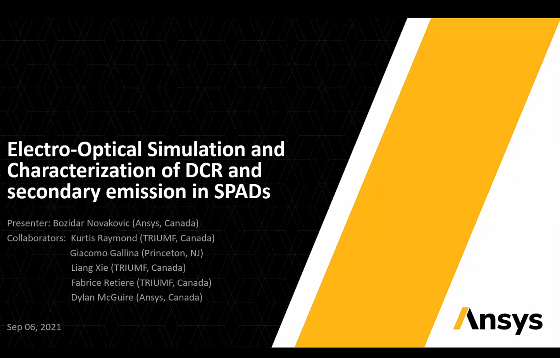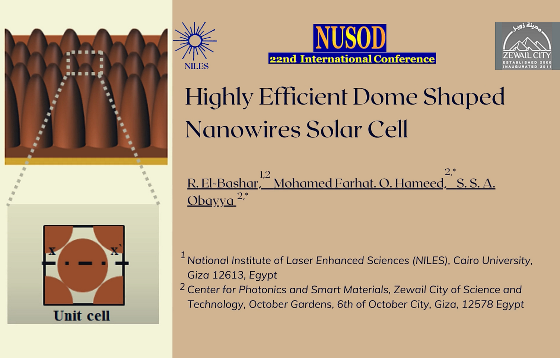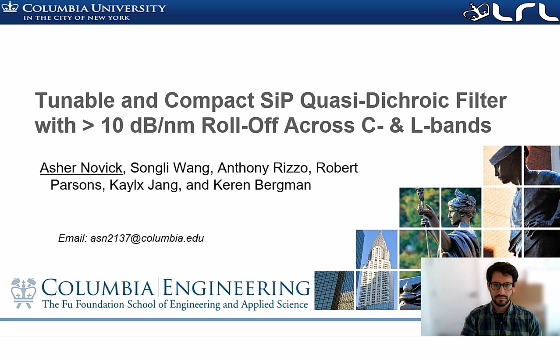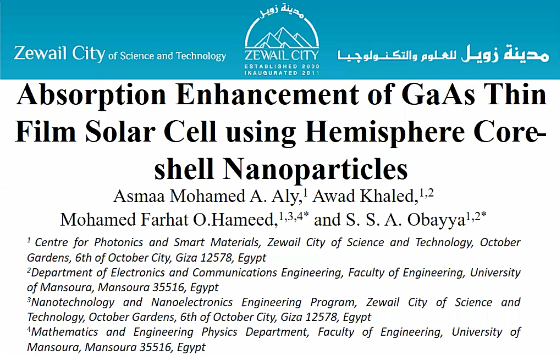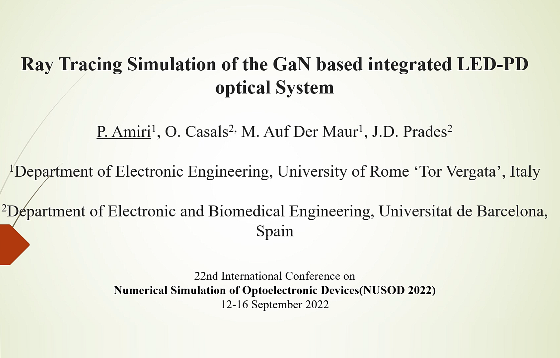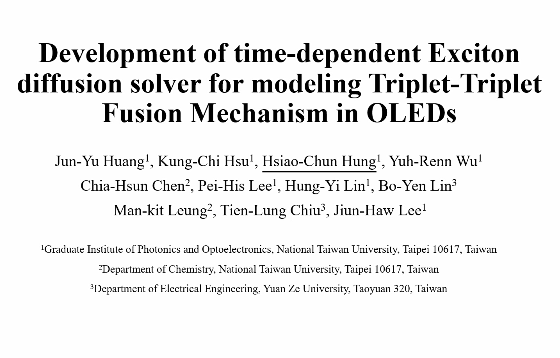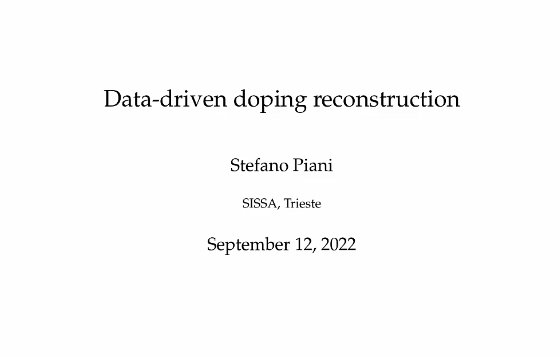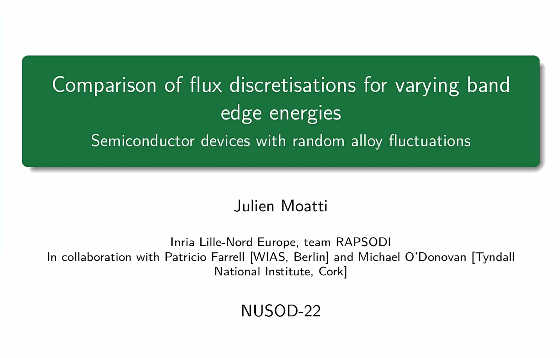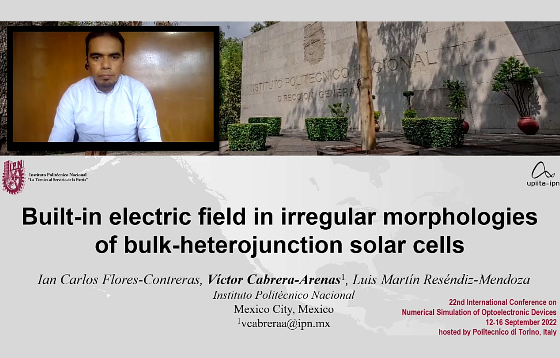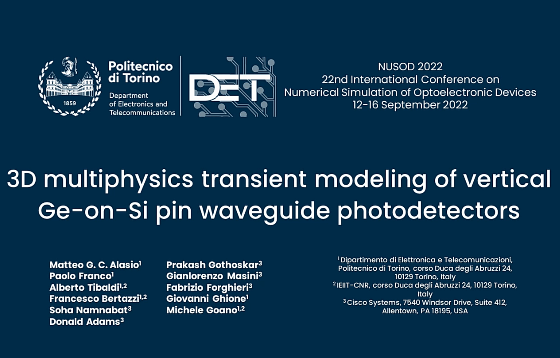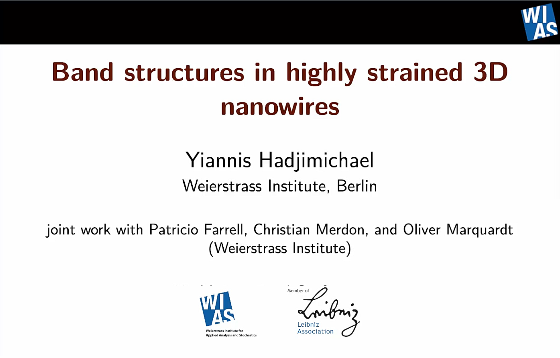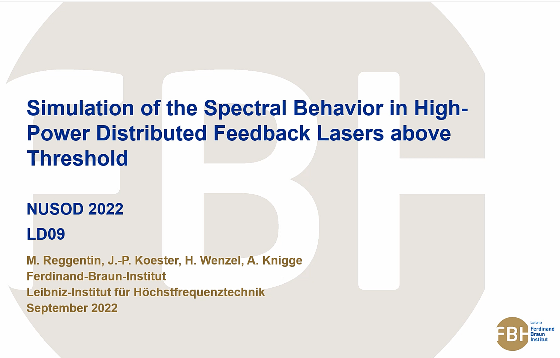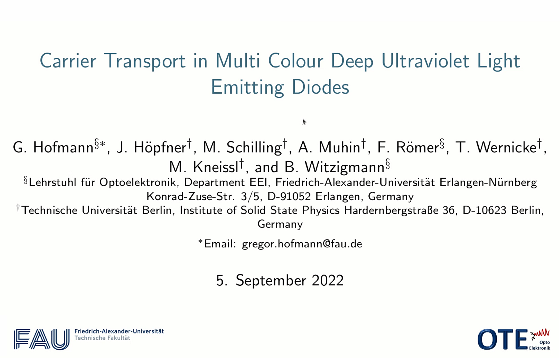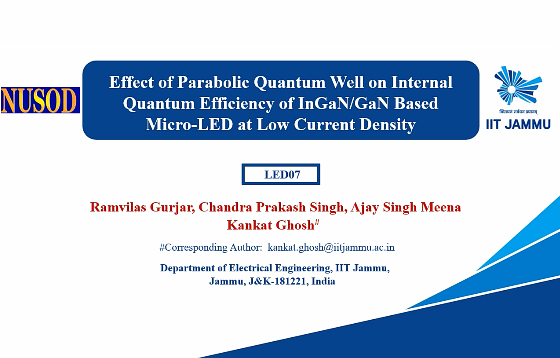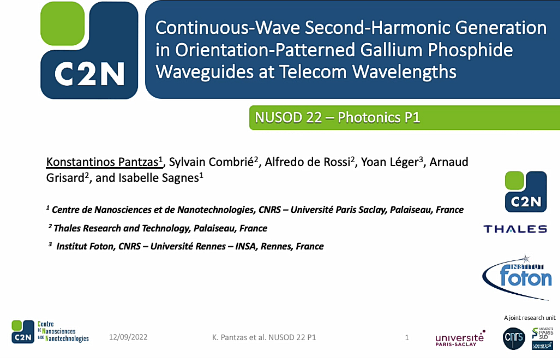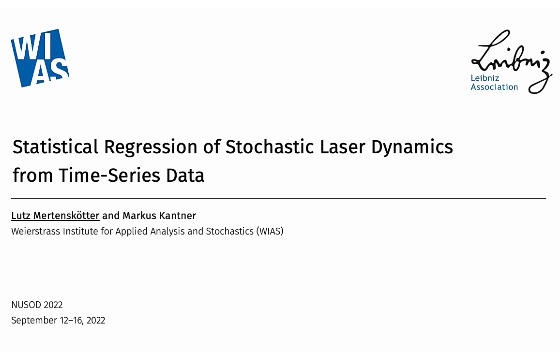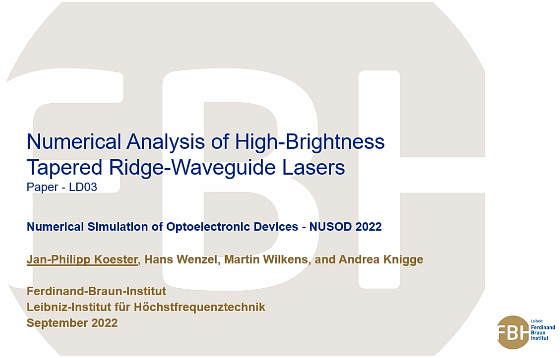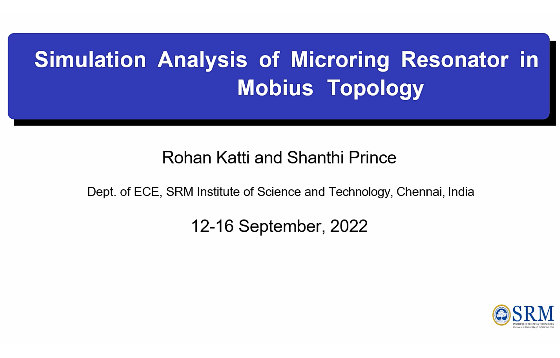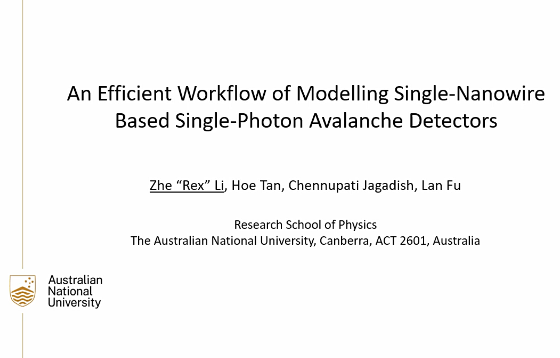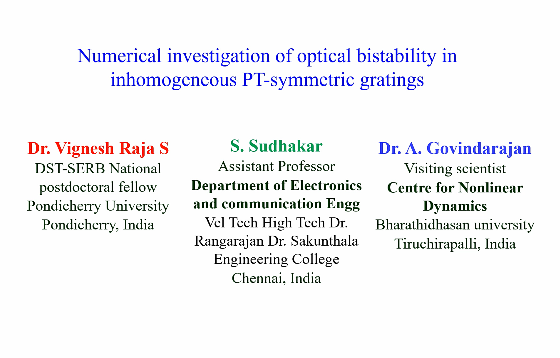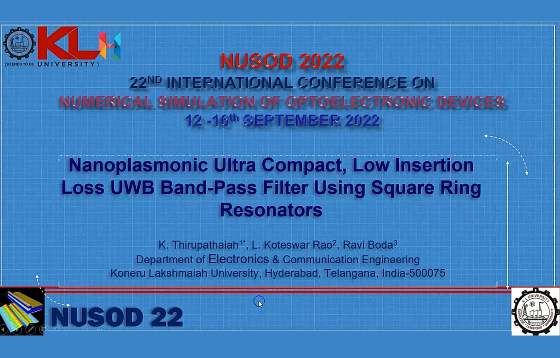


The most general motion of a system is a superposition of its normal modes, or eigenstates. We report our recent developments of a rigorous modal analysis of electromagnetic resonators, which is accurate even for geometries that have not been analyzed so far, e.g. 3D resonators made of dispersive media and placed in non-homogeneous backgrounds (on […]
LD02 – Microscopic modeling of interface roughness scattering and application to the simulation of quantum cascade lasers
The theory of interface roughness (IFR) scattering in semiconductor heterostructures is well established in the case of idealized abrupt interfaces. However, in reality, interfaces have a finite width, i.e. interfaces are graded. In such case, the effect of interface roughness, i.e. the breaking of in-plane invariance, a general framework has been lacking to describe the […]
D07 – Theoretical study of back-to-back avalanche photodiodes for mid- and longwave infrared applications
The dual-band N+-p-p-p-P+-p-p-p-n+ avalanche photodiode (APDs) structure is designed and numerically analyzed in detail. We conducted a theoretical study of APD for medium wave (MWIR) and longwave infrared (LWIR) applications. The current-voltage (I-V) characteristics for the bias range -6V
N08 – Inverse Design of Multilayer Thin film by Deep Neural Network
Inverse Design of TiO2 − SiO2 based multilayer thin film for normal incidence of TM polarized light in visible region by Deep Neural Network is reported. The simulated and the target transmission spectra are closely following.
P07 – Low-Cross-Talk Metal-Dielectric-Metal Waveguide Intersections Based on Sodium
We analyzed the transmission properties of two plasmonic waveguides crossing by using numerical simulations. The subwavelength width waveguides are composed of sodiumair-sodium. The crossing structure is composed by a compact cross-shaped resonant cavity with a four-fold symmetry. The results demonstrated the feasibility of using sodium as a low loss material for several applications for nanoplasmonic […]
P18 – The counter-propagating traveling-wave technique for optimizing a continuous-wave fiber laser presenting excited state absorption
We report results of simulation of a continuous-wave fiber laser with active medium presenting an excited state absorption. The laser was simulated using the counterpropagating traveling-wave technique with taking into account two laser waves propagating along the laser cavity in opposite directions, two waves of amplified spontaneous emission, and exited state absorption observed for both […]
SC02 – Numerical simulation of eco-friendly 4-terminal all perovskite tandem solar cell using novel HTL structure in the bottom sub cell
In this paper, we proposed a free-pb 4-terminal (4T) all perovskite tandem solar cell (APTSC) as reference with the power conversion efficiency (PCE) of 26.42% . First, a 100 nm MgF2 thin film is used as an antireflection layer (ARL) of the top sub cell to improve the total PCE of the reference structure. The […]
MM09 – FiPo FDTD: Computational Electrodynamics Technique Producing Both Fields and Potentials
We present the field–potential finite-difference time-domain (FiPo FDTD) algorithm, which solves a set of first-order equations for the electric and magnetic fields (E and H), as well as the magnetic vector potential A and the scalar electric potential φ in the Lorenz gauge. We also present the derivation and implementation of a convolutional perfectly matched […]
D02 – Electro-Optical Simulation and Characterization of DCR and secondary emission in SPADs
We demonstrate the use of simulations in the modeling and characterization of important aspects of Single Photon Avalanche Detectors (SPADs). Electrically, we discuss the use of drift-diffusion and avalanche triggering probability solvers and results for dark count rate (DCR) and their comparison to measurements. Optically, we discuss the use of full wave electromagnetic solvers to […]
SC05 – Highly Efficient Dome Shaped Nanowires Solar Cell
The optical characteristics of Si dome-tapered nanowires (NWs) solar cell (SC) are reported and analyzed by using finite difference time domain method. The geometrical parameters are studied to maximize the light absorption and hence the ultimate efficiency and short circuit current density of the reported NWs SC. The dome-shaped NWs show better absorption enhancement than […]
P05 – Tunable and Compact SiP Quasi-Dichroic Filter with ≥10 dB/nm Roll-Off Across C- & L-bands
We report simulated performance for an integrated and compact silicon photonic quasi-dichroic filter with ≥10 dB/nm roll-off and ≥20 dB extinction ratio between pass and stop bands. Additionally, the cutoff wavelength and compensation for fabrication error are each thermally tunable. The functional dichroic bandwidth is ≈80 nm, which spans most practical use cases.
SC06 – Absorption Enhancement of GaAs Thin Film Solar Cell using Hemisphere Core-shell Nanoparticles
A novel design of GaAs solar cell (SC) is proposed and analyzed. Hemisphere core shell structures are placed over the surface of the SC to harvest more energy and increase the solar cell efficiency. The GaAs and GaSb are used as core/shell materials to increase the wavelength coupling between the dual cores of the proposed […]
LED06 – Ray Tracing Simulation of a GaN-based integrated LED-Photodetector System
An optical sensor system consisting of a pair of GaN LED and Photodetector (PD) is simulated using COMSOL Multiphysics, and the possibility of using this system as absorption coefficient sensor is studied. By locating both LED and PD on a same substrate and measuring transmitted power to the PD, it would be possible to sense […]
LED04 – Development of time-dependent Exciton diffusion solver for modeling Triplet-Triplet Fusion Mechanism in OLEDs
In this work, we developed a both stable and time-dependent exciton diffusion model including singlet and triplet exciton coupled with a modified Poisson & drift-diffusion solver to demonstrate the mechanism of triplet-triplet fusion (TTF) OLEDs. Using this modified simulator, we can demonstrate the characteristics of OLEDs including current-voltage curve, quantum efficiency performance, time-resolved electroluminescence spectrum, […]
MM08 – Data-driven doping reconstruction
To reconstruct doping profiles via opto-electronic techniques (e.g. LBIC and LPS), we formulate an inverse problem based on the van Roosbroeck system. To solve it, we use neural networks fed with data created from efficient implementations of the forward model. We discuss errors of the reconstructed doping profiles as well as their robustness with respect […]
MM05 – Comparison of flux discretizations for varying band edge energies
Recently, a multiscale framework was developed where drift-diffusion is combined with atomistic tight-binding models. A naive flux discretization was proposed to tackle the problem of heavily fluctuating band edge energies which does not take into account mathematical complications. Here we would like to present several alternatives and compare them.
SC01 – Built-in electric field in irregular morphologies of bulk-heterojunction solar cells
This paper theoretically analyzes the built-in electric field distribution in bulk heterojunction solar cells. The approach proposed leads to explore the impact of regular and irregular morphologies on the performance of these devices. The width of the depletion region at the donor-acceptor interface is set by the doping concentration. The proposed analysis resulted in the […]
D03 – 3D multiphysics transient modeling of vertical Ge-on-Si pin waveguide photodetectors
We report transient simulations of Ge-on-Si vertical pin waveguide photodetectors (WPDs), where the optical generation term used by the time-domain model is the FDTD solution of the electromagnetic problem treated as a spatially-distributed pulsed signal. This approach, validated against experimental measurements of the frequency response, paves the way to future studies of the dynamic response […]
N03 – Band structures in highly strained 3D nanowires
We mathematically derive a new nonlinear strain model to simulate the conduction and valence bands in highly bent 3D hexagonal nanowires with GaAs core and asymmetric (AlαIn1-α)As stressor. The model is based on a transformation of the 1st Piola-Kirchhoff stress tensor and an appropriate energy functional that captures the dynamics of the induced strain due […]
LD09 – Simulation of the Spectral Behavior in High-Power Distributed Feedback Lasers above Threshold
We report on the simulations of mode hopping behavior in semiconductor distributed feedback lasers with asymmetric facet reflectivities above threshold and its dependence on the phase between the grating and the high reflective facet.
LED02 – Carrier Transport in Multi Colour Deep Ultraviolet Light Emitting Diodes
Deep ultraviolet (DUV) light emitting diodes (LEDs) and lasers are enabled by high band gap Aluminium Gallium Nitride (AlGaN). The efficiency of recent multi quantum well (MQW) DUV emitters is still in the percent range which can be in part attributed to the hole injection. The hole injection and the carrier distribution in the high […]
LED07 – Effect of Parabolic Quantum Well on Internal Quantum Efficiency of InGaN/GaN based MicroLED at low current density
The quantum cascade stark effect (QCSE) in rectangular shaped quantum well (QW) poses a hindrance to increase the internal quantum efficiency (IQE) of nitride based LEDs. To circumvent the said problem for micro-LEDs operating at low current density, a parabolic QW structure has been proposed which is found to be useful to alleviate the QCSE […]
P01 – Continuous-Wave Second-Harmonic Generation in Orientation-Patterned Gallium Phosphide Waveguides at Telecom Wavelengths
A new process to produce Orientation-Patterned Gallium Phosphide (OP-GaP) on GaAs with almost perfectly parallel domain boundaries is presented. Taking advantage of the chemical selectivity between phosphides and arsenides, OP-GaP is processed into suspended shallow-ridge waveguides. Efficient Second-Harmonic Generation from Telecom wavelengths is achieved in both Type-I and Type-II polarisation configurations. The highest observed conversion […]
LD05 – Data-Driven Modeling of Non-Markovian Noise in Semiconductor Lasers
Non-Markovian noise degrades the coherence properties of semiconductor lasers and contributes significantly to broadening of the linewidth. Since modeling of such colored noise systems from first principles is not accessible, we aim for a data-driven modeling approach in which a system of stochastic rate equations shall be reconstructed from time series data.
LD03 – Numerical Analysis of High-Brightness Tapered Ridge-Waveguide Lasers
In this work, we present a simulation-based analysis of a CW driven tapered ridge-waveguide laser having a high lateral brightness of 5 W · mm−1mrad−1 at 2.5 W optical output power.
P17 – Simulation Analysis of Microring Resonator in Mobius Topology
In this paper, a microring resonator in Mobius topology is modelled and simulation analysis is carried out. The free spectral range of this silicon-on-insulator based photonic device is found to be 23.4 nm. This structure of microring resonator finds place in various applications such as sensors, polarization analysis, wavelength-selective reflectors.
N04 – An Efficient Workflow of Modeling Single-Nanowire Based Single-Photon Avalanche Detectors
Single-photon detector (SPD) as an essential building block for detecting and counting photons, plays a fundamental role in quantum technologies. In this work, we propose an efficient workflow of modeling SPDs based on emerging one-dimensional materials, i.e. nanowires, utilizing avalanche breakdown in reverse biased condition. Comparing to another extensively studied platform, superconducting nanowire SPDs, avalanche […]
P21 – Numerical investigation of optical bistability in inhomogeneous PT -symmetric gratings
Customizing the nonlinear profile along the direction of propagation helps in the realization of low-power all-optical switches. The switching intensities are extremely low (<0.01) in the broken regime provided that the light launching direction is right. It is believed that the switching intensities in the broken regime are always higher than that of the unbroken […]
P23 – Nanoplasmonic Ultra Compact, Low Insertion Loss UWB Band-Pass Filter Using Square Ring Resonators
This article presents the design and analysis of a nanoplasmonic ultra wide band (UWB) band-pass filter based on metal insulator metal (MIM) slot-waveguide using three square ring resonators (SRRs) for obtaining ultra wide band nature at optical frequencies. This filter shows the low insertion loss due to the zero coupling gaps and no mismatch between […]

